Table of Contents
EVENTS
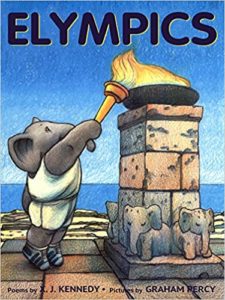 |
In poet X.J. Kennedy’s Elympics (Philomel, 1999), 13 short poems and a cast of adorable and athletic elephants celebrate the events of the Olympic games, including skiing, skating, sprinting, and diving – plus hard work and good sportsmanship. For age 4-8. |
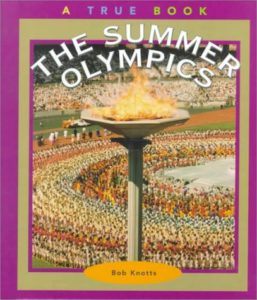 |
By Bob Knotts, The Summer Olympics (Childrens Press, 2000) is a photo-illustrated account for ages 5-8. In similar format, see The Winter Olympics by Larry Dane Brimner. |
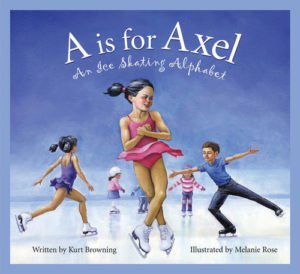
|
By skater Kurt Browning, A is for Axel (Sleeping Bear Press, 2005) is an illustrated alphabet of ice skating in short rhymes. Notes in the margins provide more detailed information. For ages 6-9. |
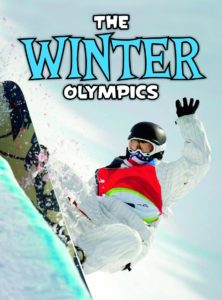 |
Nick Hunter’s The Winter Olympics (Capstone, 2013) is a general 32-page overview of the Olympics, covering basic events (plus a chapter on the Paralympics). Illustrated with color photos. For ages 7-10. |
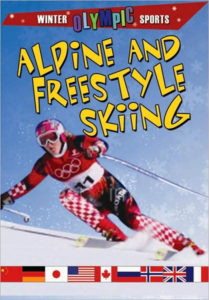
|
The Winter Olympic Sports series (Crabtree Publishing) covers them all, in a series of 32-page, photo-illustrated books. Titles include Figure Skating (Joseph Gustaitis), Alpine and Freestyle Skiing (Kylie Burns), Ice Hockey and Curling (Robin Johnson), and Speed Skating (Joseph Gustaitis). For ages 8 and up. |
| From Activity Village, Winter Olympics has coloring pages, word puzzles, printable story paper, and crafts, categorized by winter sport. Kids can make a ski collage or a model ice rink. | |
| For high-school-level students, The Winter Olympic Games Project has kids researching game events and making representative posters. | |
| A Map of Olympic Medals is an infographic in which visitors can click on a year and a country for a list of medal winners. (Opportunities for creative math and geography projects here.) |
ATHLETES
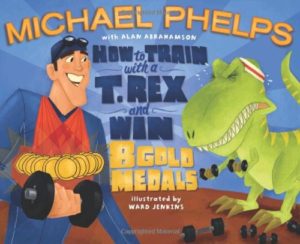
|
Swimmer Michael Phelps’s picture book How to Train with a T. Rex and Win 8 Gold Medals (Simon & Schuster Children’s Publishing, 2009) describes – with catchy analogies – just what it took to train for the 2008 Olympics, at which Phelps won a phenomenal eight gold medals. For example, he trained for six years (“That’s a kindergartener’s whole life! That’s the same as 42 dog years!”), swam 60,000 meters a week for a total of 12,480 miles (like swimming three times the length of the Great Wall of China), and developed legs strong enough to lift one Tyrannosaurus rex + 10 velociraptors. A nice starting point for some creative Olympics-based math. For ages 5-9. |
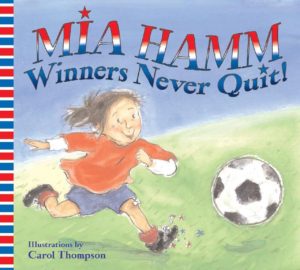
|
Olympic soccer champion Mia Hamm’s cartoonishly illustrated Winners Never Quit (HarperCollins, 2006) is a charming pseudo-autobiographical tale about a little girl (named Mia) who loves playing soccer, but hates to lose – so much so that she throws a fit and quits when she fails to score. Friends and family, however, help her learn that playing the game is about love of the sport and cooperation more than about winning and losing. In this winning-obsessed day, a nice lesson for ages 4-7. |
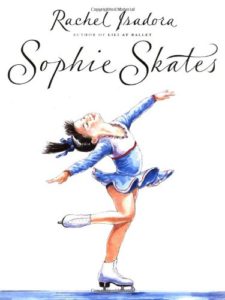
|
In Rachel Isadora’s watercolor-illustrated picture book Sophie Skates (Scholastic, 2002), eight-year-old Sophie dreams of becoming a professional ice skater. The book follows Sophie in her weekly skating lessons; readers learn about skating equipment, moves, competitions, and the hard work and practice it takes to be a champion. For ages 4-8. |
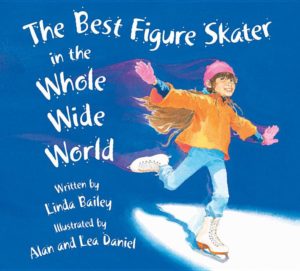
|
In Linda Bailey’s The Best Figure Skater in the Whole Wide World (Kids Can Press, 2003), Lizzy is determined to become a champion figure skater – but when her skating class prepares to perform “Snow White and the Seven Dwarfs” at the upcoming winter festival, Lizzy is cast as a tree. For ages 5-8. |
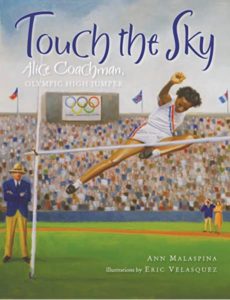
|
Ann Malaspina’s Touch the Sky (Albert Whitman & Company, 2011) is a free-verse picture-book biography of high jumper Alice Coachman who, in 1948, became the first African-American woman to win an Olympic gold medal. (“Alice Coachman raced/down the dirt road/bare feet flying,/long legs spinning,/braids flapping/in the wind…/LEAP!”) Included in an Author’s Note are photos of the real Alice and her teammates. For ages 5-9. |
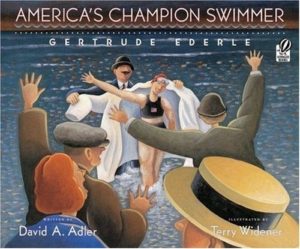
|
David A. Adler’s America’s Champion Swimmer (Sandpiper, 2005) is a picture-book biography of Olympic gold medalist Gertrude Ederle who, in 1926, also became the first woman to swim the English Channel. For ages 6-9. |
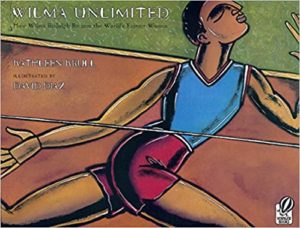
|
Wilma Rudolph, star of Kathleen Krull’s gorgeously illustrated 44-page biography Wilma Unlimited: How Wilma Rudolph Became the World’s Fastest Woman (Sandpiper, 2000), was born in Tennessee in 1940, youngest in a family of twenty children. At the age of five, she had polio and was expected never to walk again – but through sheer determination, she not only walked, but ran, and so well that, in the 1960 Olympics, she became the first woman to win three gold medals. An inspirational tale for ages 7-12. |
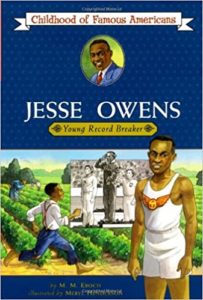
|
In the red, white, and blue Childhood of Famous Americans series, M.M. Eboch’s Jesse Owens: Young Record Breaker (Aladdin, 2008) is a fictionalized chapter biography of the childhood of African-American runner Jesse Owens, who overcame racism and poverty to win four gold medals in the 1936 Olympics, held in Hitler’s Germany. The book is dedicated to “anyone who refuses to give up.” For ages 7-10. |
| In the same series, also see Jo Harper’s Wilma Rudolph: Young Runner (Aladdin, 2004) and Guernsey Van Riper’s Jim Thorpe: Olympic Champion (Aladdin, 1986). | |
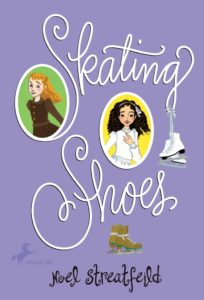
|
Noel Streatfeild’s Skating Shoes (Yearling, 2009), Harriet’s doctor prescribes skating to help her recover from an illness, and soon Harriet makes friends with orphan Lalla, training to be a skating champion, and discovers her own talent on the rink. One of the wonderful Shoes series, originally published in the 1930s and 40s, about children in the performing arts. For ages 8-12. |
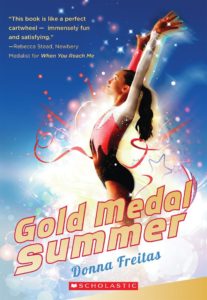
|
The protagonist of Donna Freitas’s novel Gold Medal Summer (Arthur A. Levine, 2012) is thirteen-year-old gymnast Joey Jordan, determined to be a gold medal winner, who struggles with not-always-easy relationships with her coach, friends, and family, and begins a romance with old friend (now suddenly cute boy) Tanner. For ages 10 and up. |
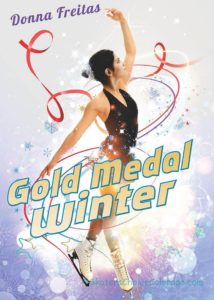 |
In Freitas’s Gold Medal Winter (Scholastic, 2014), Esperanza Flores of the Olympic ice skating team deals with sudden fame, mean-spirited teammates, budding romance (with a hockey player?), and a passionate desire to win. For ages 10-14. |
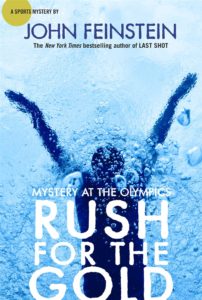
|
In John Feinstein’s Rush for the Gold (Knopf Books for Young Readers, 2012), one of a series of sports-based mysteries starring teenaged journalists Steven Thomas and Susan Carol Anderson, Susan – a champion swimmer – is competing at the London Olympic Games. Stevie, however, begins to suspect that someone is trying to rig the swimming competitions, and soon he and Susan Carol have joined forces to solve the mystery. For ages 10 and up. |
| From Good Education, Fists of Freedom tells the story behind the famous raised-fists photograph of Olympic medalists Tommie Smith and John Carlos, protesting racial discrimination at the 1968 Olympic Games in Mexico City. | |
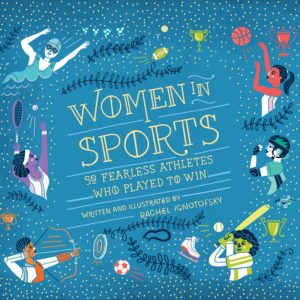 |
Rachel Ignotofsky’s Women in Sports (Ten Speed Press, 2017) is a gorgeously designed collection of 50 short biographies of great female athletes. For ages 9-12. |
